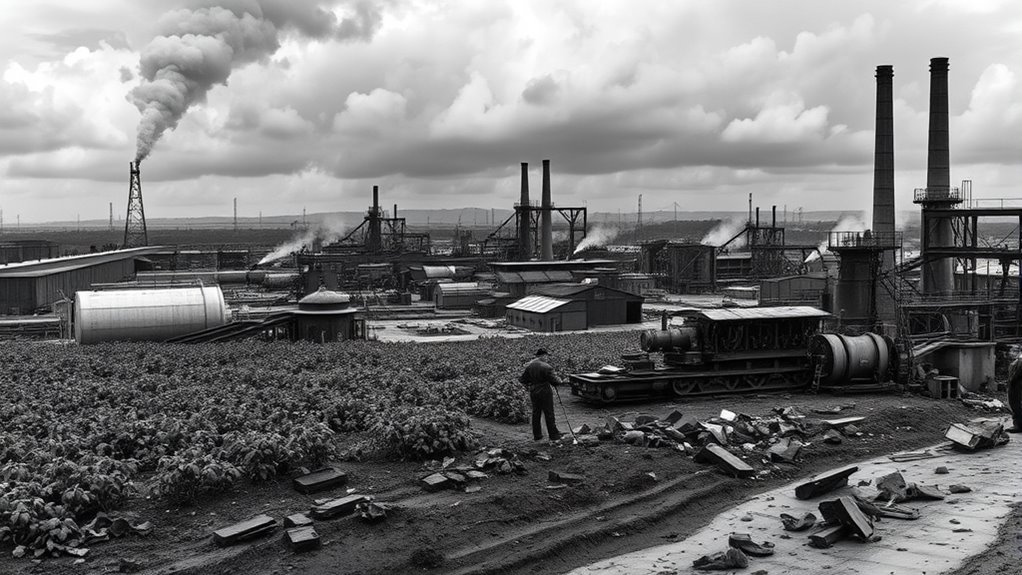During WWII, synthetic rubber became essential as natural supplies ran out, pushing industries to innovate and produce large quantities from petrochemicals like styrene and butadiene. This breakthrough reduced dependence on natural rubber and helped maintain military and civilian supplies. After the war, natural rubber supplies recovered, causing a decline in synthetic rubber demand. However, its development changed manufacturing forever, and if you want to discover how this technological shift unfolded, keep exploring the story behind this critical innovation.
Key Takeaways
- Synthetic rubber’s rise was driven by WWII shortages of natural rubber, necessitating large-scale petrochemical production.
- Wartime innovations improved polymerization techniques, resulting in durable synthetic rubber suitable for military and industrial use.
- Production faced challenges like raw material fluctuations, but capacity rapidly increased to meet wartime demands.
- Post-war, natural rubber supplies recovered, reducing reliance on synthetic rubber, which remained vital for specialized applications.
- The development of synthetic rubber during WWII exemplified how wartime needs accelerated chemical industry innovation.

During World War II, the demand for rubber skyrocketed as nations relied heavily on tires, aircraft, and military equipment. With natural rubber supplies cut off due to Japanese control of key regions, the Allies faced a critical shortage. This scarcity pushed researchers and industries to develop synthetic rubber as a essential alternative. The process involved significant advances in chemical manufacturing, transforming raw chemicals into usable materials efficiently and on a massive scale. Wartime innovation played a pivotal role, as scientists and engineers worked tirelessly to create reliable synthetic alternatives that could meet wartime needs. These efforts resulted in the production of synthetic rubber from petrochemical feedstocks like styrene and butadiene, which were derived from crude oil—a resource more accessible during the war.
During WWII, synthetic rubber production surged, transforming chemical manufacturing to meet critical wartime needs and reduce reliance on natural sources.
The development of synthetic rubber became a top priority for the United States and its allies. They set up large-scale industrial plants dedicated to chemical manufacturing, aimed at producing enough synthetic rubber to sustain the war effort. This effort wasn’t just about scaling up; it involved optimizing processes, improving yields, and ensuring consistent quality. Wartime innovation extended beyond the chemical processes; it also included new techniques for polymerization, which allowed for more durable and versatile rubber products. As a result, synthetic rubber could be used in tires, hoses, seals, and aircraft tires, often outperforming natural rubber in harsh conditions. This technological leap was essential for maintaining mobility and logistical support in the war.
However, the reliance on synthetic rubber had its challenges. The complex chemical manufacturing processes required a skilled workforce and substantial infrastructure investments. During the war, these plants operated under intense pressure to meet skyrocketing demand, often facing issues like fluctuating raw material supplies and production bottlenecks. Despite these hurdles, wartime innovation proved resilient, and synthetic rubber production ramped up rapidly. This shift not only helped the Allies avoid dependence on limited natural rubber sources but also laid the groundwork for post-war industrial advancements in polymer chemistry. 16PF insights into personality traits can be useful for managing teams in such high-pressure environments, ensuring effective collaboration and problem-solving during critical periods.
In the end, the rise of synthetic rubber during WWII exemplifies how wartime needs spurred a leap in chemical manufacturing techniques and innovation. It transformed the rubber industry and demonstrated the power of scientific ingenuity in times of crisis. Although the war eventually ended and natural rubber supplies recovered, synthetic rubber remained an essential component of modern industry, a lasting legacy of wartime innovation and resourcefulness.
Frequently Asked Questions
What Were the Main Alternative Materials Used During Rubber Shortages?
During rubber shortages, you relied on natural substitutes like balata, gutta-percha, and rubber from sources like Manila and rubber trees. Metal alternatives, such as steel and aluminum, helped replace rubber in certain applications like gears and seals. You also used textiles and leather in some areas to conserve rubber. These materials helped mitigate shortages and keep essential wartime equipment functioning despite limited synthetic rubber availability.
How Did Synthetic Rubber Influence Post-War Automotive Industries?
Coincidentally, synthetic rubber transformed your post-war automotive experience by boosting economic dependency on new materials. Thanks to technological advancements, car manufacturers could produce tires and parts more efficiently, reducing costs and increasing availability. This innovation led to a boom in car production and paved the way for modern automotive industries. You now benefit from better, more durable vehicles, all thanks to synthetic rubber’s pivotal role in shaping the industry’s post-war recovery.
What Environmental Impacts Resulted From Synthetic Rubber Production?
You should know that synthetic rubber production caused significant environmental pollution and resource depletion. The manufacturing process releases pollutants into air and water, harming ecosystems and human health. Additionally, it consumes large amounts of non-renewable resources like petroleum, leading to resource depletion. These environmental impacts highlight the need for greener alternatives and sustainable practices in rubber and polymer industries to reduce pollution and conserve resources for future generations.
Were There Any Notable Geopolitical Conflicts Over Rubber Resources?
You should know that during WWII, there were notable geopolitical conflicts over rubber resources, driven by the need to control rubber supply. Nations competed fiercely for access to rubber-producing regions, leading to increased geopolitical tensions. These conflicts prompted countries to seek synthetic alternatives and secure supply chains, highlighting how essential rubber was to wartime logistics and the global struggle for resources. This rivalry underscores the strategic importance of rubber during that era.
How Did Synthetic Rubber Innovations Affect Other Wartime Technologies?
Synthetic rubber innovations, driven by chemical synthesis and industrial advancements, profoundly impacted wartime technologies. You see, these innovations led to stronger, more durable materials for tires, aircraft parts, and military equipment. By improving efficiency and resilience, they allowed for better performance in harsh conditions. As a result, your military equipment became more reliable, giving you a strategic edge. These breakthroughs also spurred further technological progress during the war.
Conclusion
You’ve seen how synthetic rubber became essential during WWII, with production soaring by over 400% to meet wartime demands. Yet, its rise was fleeting, overshadowed by environmental concerns and resource shifts. Imagine knowing that in just a few years, the world’s reliance on synthetic rubber changed dramatically—highlighting how innovation can both save and challenge us. This story reminds you that even the most important inventions are subject to the tides of history and nature.









